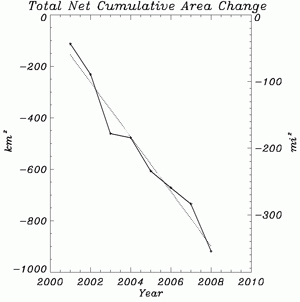Greenland is losing ice three times faster than last year, report researchers presenting at the meeting of the American Geophysical Union in San Francisco.
Monitoring satellite images of Greenland to determine how much ice flows from landlocked glaciers towards the ocean to form floating ice shelves, which eventually break off into the sea, Jason Box of Ohio State and colleagues found that ice loss nearly tripled between in the summer of 2006-2007 and the summer of 2007-2008. Box estimates that Greenland has lost 55.4 square miles (920.5 square kilometers) — an area more than 10 times the size of Manhattan — since 2000.
“We now know that the climate doesn’t have to warm any more for Greenland to continue losing ice,” Box said. “It has probably passed the point where it could maintain the mass of ice that we remember.”
“But that doesn’t mean that Greenland’s ice will all disappear. It’s likely that it will probably adjust to a new ‘equilibrium’ but before it reaches the equilibrium, it will shed a lot more ice,” he continued. “Greenland is deglaciating and actually has been doing so for most of the past half-century.”
Box says warming climate around Greenland is believed to be speeding the melt.

Our survey of 32 of the largest Greenland tidewater glaciers
indicates a continuous collective retreat end of summer 2000
onward to 2008.
A best-fit line indicates a -106.4 sq. km/yr area change around
Greenland. The linear correlation coefficient is -0.98.
The cumulative area change from end of summer 2000 to 2008 is
-920.5 sq km, an area loss equivalent with 10.5 times the area
of Manhattan Is., New York.







